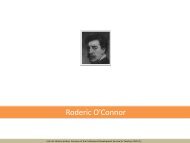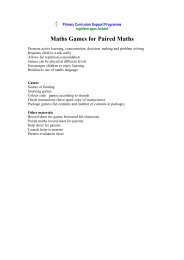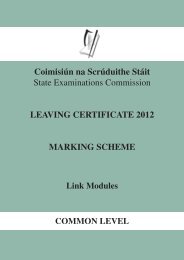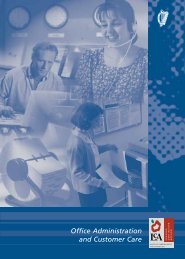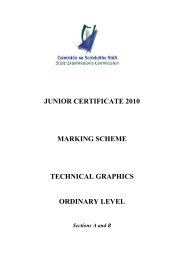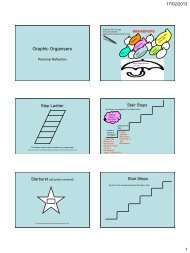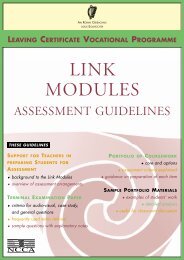What is Four in Balance? - PDST
What is Four in Balance? - PDST
What is Four in Balance? - PDST
You also want an ePaper? Increase the reach of your titles
YUMPU automatically turns print PDFs into web optimized ePapers that Google loves.
StructureTim<strong>in</strong>gEp<strong>is</strong>temologyClassroomsituationKnowledge transferOffer<strong>in</strong>g knowledge <strong>in</strong> a clearlydef<strong>in</strong>ed and structured (step-bystep)mannerTeacher (or computer) decideswhat knowledge pupils are givenand whenWell-def<strong>in</strong>ed and solvableproblems, with correct solutionsQuiet and concentration <strong>in</strong>classroom, attention focused onteacherKnowledge constructionFocus<strong>in</strong>g on the end product,facilitat<strong>in</strong>g the pupil’s processof <strong>in</strong>vestigationPupil directs learn<strong>in</strong>g and <strong>is</strong> anactive participant <strong>in</strong> knowledgeacqu<strong>is</strong>itionEncourag<strong>in</strong>g pupils to search fornew solutionsActive work attitude, work<strong>in</strong>g<strong>in</strong>dependently and <strong>in</strong> collaboration,not limited to classroomTest<strong>in</strong>g Pupils tested on content Assessment of learn<strong>in</strong>g processLearn<strong>in</strong>g objectiveAcquir<strong>in</strong>g a knowledge of factsand conceptsDevelop<strong>in</strong>g the ability toconceptualize and reasonTable 2.1: Compar<strong>in</strong>g knowledge transfer and knowledge construction (based on OECD, 2009,Chapter 4)Knowledge transfer and knowledge construction should be viewed asabstractions or idealizations (shown <strong>in</strong> Table 2.1). Pure forms seldomoccur <strong>in</strong> reality, however, and <strong>in</strong> the classroom, teachers tend to use both– although Chapter 4 will show that teachers express a certa<strong>in</strong> or even astrong preference for knowledge transfer. It <strong>is</strong> expected, however, thatknowledge construction will ga<strong>in</strong> <strong>in</strong> importance.Knowledge transfer and knowledge construction us<strong>in</strong>g ICTThe Kenn<strong>is</strong>net studies can easily be divided <strong>in</strong>to those concern<strong>in</strong>gknowledge transfer and those concern<strong>in</strong>g knowledge construction. It <strong>is</strong>useful to have a clear explanation of the difference between the twocategories. Knowledge transfer <strong>in</strong>cludes such strategies as “<strong>in</strong>struction”and “structured practice”; knowledge construction <strong>in</strong>cludes such strategiesas “<strong>in</strong>quiry-based learn<strong>in</strong>g” and “learn<strong>in</strong>g to learn” (which will beexpla<strong>in</strong>ed <strong>in</strong> detail <strong>in</strong> the sections below). ICT can be deployed <strong>in</strong> eachof these strategies but the objectives will differ and so will the benefits.Table 2.2 l<strong>is</strong>ts the four above-mentioned (ideal) strategies along with atypical example of each one and a typical learn<strong>in</strong>g objective.18



